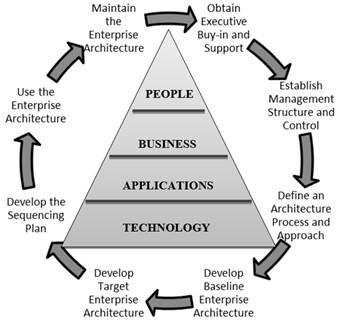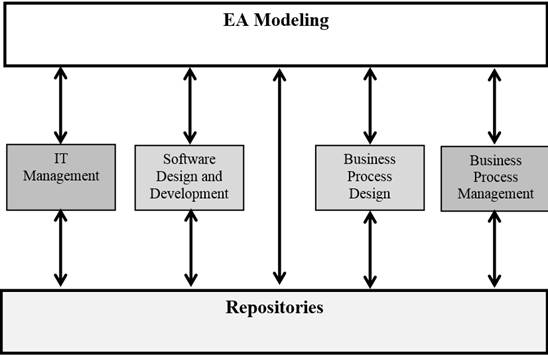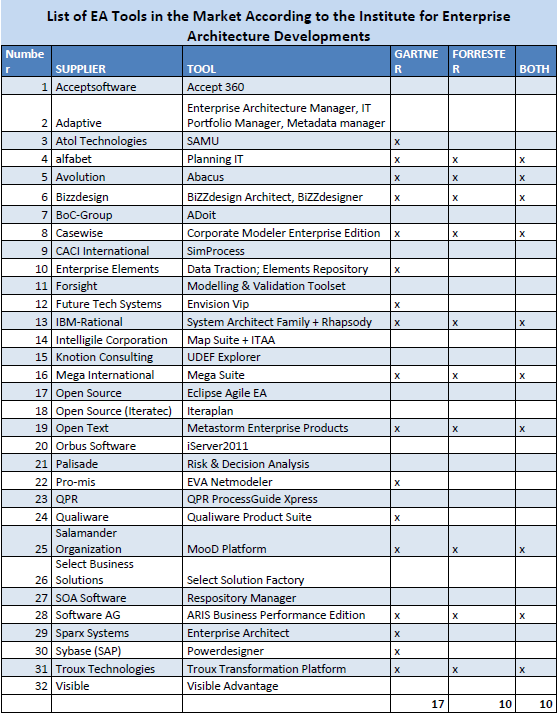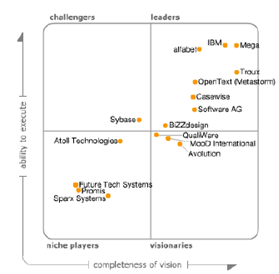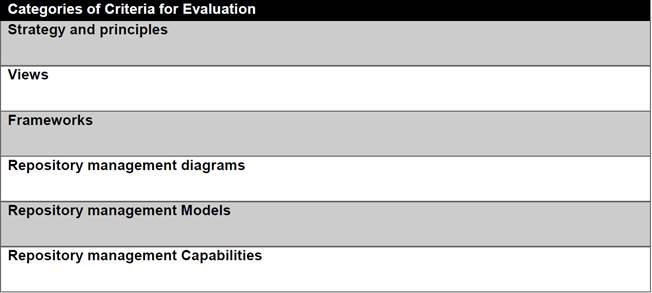1. Introduction
In recent years Enterprise Architecture (EA) has emerged as one of the most important topics to consider in Information Systems studies and has grown to become one of the most important tasks in a working business (Bricknal, Darrell, Nilsson, & Pessi, 2011). According to Gartner (Gartner Inc., 2013a) “Enterprise Architecture is the process of translating business vision and strategy into effective enterprise change by creating, communicating and improving the key requirements, principles and models that describe the enterprise’s future state and enable its evolution”.
Practitioners in EA are often called Enterprise Architects. Enterprise Architects use principles, methods, models and frameworks to design the current and future state of the business and to present a holistic view of the company. To fulfill its purpose, enterprise architects use EA software tools (for simplicity we will call them tools in this paper). These EA software tools support Enterprise Architects to define mission, vision and strategy, business processes, organizational entities, information systems, technical infrastructure and their relations.
Nowadays in the market there are many tools that help Enterprise Architects to implement EA. In order to decide which tool would be better suited for an organization is important to use a good software evaluation methodology. A good methodology should guide the evaluator on how to choose the relevant criteria and weight these criteria according to the current and future needs of the business (Handler & Wilson, 2009). Furthermore due to market uncertainty it is important to consider the possibility to work with the customer’s preferred vendor or with a “one size fits all” tool. Organization following such decision can realize benefits as reduced training, shared licenses, maintenance and easier data interchange (The Open Group, 2011).
This study will aid companies and individuals interested in working with EA to have a general vision of EA and the different tools available in the market. This paper can be considered as well a guide which gives more judgment parameters for enterprises that are facing an investment decision in EA tools and gives direction to choose the appropriate tool for their companies.
1.1. Goals of the paper
EA is an evolving discipline and the tools that assist the architectural effort are in a market that is still being defined. Hence the risk of adopting the wrong tool is relatively high (Peyret & Degennaro, 2011). In order to assist companies to decrease the risk of procuring the wrong EA tool, it is important to assess tools before making an investment.
This document is intended to be an additional source for people that would like to understand the state of the art of EA and EA tools and those who wish to acquire or use an EA tool for their work. Furthermore this paper presents a literature review in order to find available tools in the market, and to identify recognized sources that describe evaluation methodologies or give guidance for the selection of the appropriate EA tool for a specific company.
1.2. Motivation
Enterprise Architecture is one of the key disciplines which companies are using for building competitive advantage. The use of software tools is vital to support architects in the EA implementation and to promote an organizational change. However the EA tool´s market is growing and different challenges arise for both software vendors and customers. Taking the right decision in the procurement of an EA tool is an important step for the future success of the development of EA in an organization. One of main motivations for writing this paper is to understand the current state of the EA discipline and the EA tool´s market. The second reason is to contribute to decision-making at companies wishing to buy or learn about EA tools.
1.3. Structure of the paper
The structure of this paper is as follows. Chapter 2 presents the state of the art of EA it describes important definitions which are relevant to EA tools. This Chapter 2 also introduces Gartner Magic Quadrant and Forrester Wave as important sources of recognized consulting firms that have done previous work in assessing and positioning the EA tools. Additionally in the same Chapter a description of the selected tools and their vendors will be made. Finally, in Chapter 3 conclusions are drawn.
2. State of the Art
It is important to have a general perspective about EA and a common understanding of what has been done so far in analyzing, classifying and assessing EA tools. In this chapter these topics will be explained.
2.1. Enterprise Architecture
2.1.1. EA Definition
There are several definitions in the EA community. One of the reasons of this variety may be due to the early stages of the subject (Ivanov, 2009). An important definition of EA from Gartner was presented in the introduction of this document. Another definition of EA is given by Lankhorst (Lankhorst, 2009) “EA is a coherent set of principles, methods and models that are used in the design, realization and maintenance of an enterprise’s business architecture, organizational structure, information architecture and technology architecture with respect to the corporate strategy.” This is the definition that will be used in this paper.
As we see in both definitions EA goes beyond Business - IT alignment, EA addresses the need to manage increasing complexity and deal with continuous change by providing a holistic view of the enterprise. EA is often viewed as a management practice that helps to improve the performance of enterprises (de Vries & van Rensburg, 2008). Moreover EA addresses the problem of the increasing difficulty in delivering business value with the enterprise´s Information systems (Roger, 2007). The main methods to perform an EA are described in Figure 1: obtain executive buy-in and support, establish a management structure and control, define an architecture process and approach, develop baseline EA, develop target EA, develop the sequencing plan, use and maintain the EA.
Source: (Tucker & Debrosse, 2003)
2.1.2. EA Tools
Developing an EA requires different activities to define: the current environment of the business (the as-is situation), the roadmap to achieve the organization mission and the desired environment of the business (the to-be situation). EA is essential for organizations that want to implement novel initiatives with new or evolving information systems to optimize their business value. Moreover EA assist in understanding and improving the interrelationships between business processes, the information systems and technical infrastructure (Schekkerman, 2011).
Nowadays enterprises without an EA Business Unit face the risk of developing or buying systems that are duplicate, incompatible, unnecessary or costly to maintain and that are not aligned to the corporate strategy. An essential goal for EA´s to be valuable is that their development, maintenance implementation and visualization are supported with the right tools. Therefore it is important to make a previous analysis of what is significant for the organization, list the possible vendors that offer EA tools, evaluate the tools versus the customer specifications and needs and finally take the buying decision (Schekkerman, 2011).
EA tools can empower business and IT executives to make the right decisions in managing the portfolio of applications or the technological infrastructure that support business processes. Furthermore EA tools can help to clarify the relationship between business processes and IT environment and boost collaboration between IT and business professionals. Moreover EA tools facilitate communication between Business and IT departments through diagrams and documentation and can support architects in the application of architecture patterns and reuse of components and solutions existing in the organization (Lankhorst, 2009).
The EA market has grown over the last years. This has led to an increase of EA tools with different perspectives and functionality. Therefore it is important to categorize EA tools according to the way they tackle different business needs. In the following paragraphs a categorization according to Lankhorst is presented (Lankhorst, 2009).
Enterprise architecture modeling tools: Tools to support architects in modeling practices in all architecture layers. These layers are: People, Business, Application and Technology (See Error! Reference source not found.).
IT management tools: Support the management of IT investments and the management of the application portfolio of the enterprise (Lankhorst, 2009). The portfolio management practice “considers the entire portfolio of projects a company is engaged in, in order to make decisions in terms of which projects are to be given priority, and which projects are to be added to or removed from the portfolio” (De Reyck et al., 2005).
Software design and development tools: These tools support developers in the design phase of software development but extend their scope to business process modeling and enterprise architecture diagrams.
Business process design tools: These tools provide support for business process modeling and can be used to diagram IT and EA objects.
Business process management tools: These tools are aimed at the operational management of businesses processes.
Repositories and IT management tools: These tools are metadata repositories and IT management tools similar to a configuration management database (CMDB). Most of these tools include basic modeling functionality and strong analysis capabilities.
Figure 2 shows the categories for EA software tools. One of the important things to mention is that all categories include functionality for modeling and a repository to store architectural work. From this figure we can state that each tool has origins in IT management, software development or business process design and management.
The evolution of EA has empowered the development of new functionality in the solutions. This is the reason that nowadays some of the tools in the market can cope with many of the categories presented above. This evolution has determined two new categories: EA tools and EA Management Suites (EAMS). An EAMS supports a broader set of roles outside the EA group. EAMS provide support to different types of stakeholders, An EAMS centralizes the most-strategic information on IT and the business. EAMS are expanding from data, process, and organizational models into budgets, strategies and risks (Peyret & Degennaro, 2011).
Source: (Lankhorst, 2009, p. 259)
2.2. Evaluations of EA tools relevant in the market
New tools for developing EA are appearing in the market as the discipline evolves (Gartner 2011). Since there is a plethora of functionality in the solutions it is highly recommended to assess the modules that software solutions can offer. One important way of doing this is through reviewing documentation of recognized consulting firms which benchmark solutions in the IT markets. These reviews can give advice and guidance to choose the more adequate tool for a company.
In this research it was found that there are relatively few important initiatives for evaluating EA tools. Two trustworthy sources are presented in this paper: Gartner Magic Quadrant and The Forrester Wave. Gartner Magic Quadrant is elaborated by Gartner Inc. a leading firm specialized in Research, Consulting, Executive Programs and Events on the IT industry (Gartner Inc., 2013b). Forrester Wave is designed by Forrester Research Inc. a global research and consulting firm specialized in business and IT (Forrester, 2013a).
Table 2 shows the variety of EA tools available in the market according to the Institute for Enterprise Architecture Developments. A study was also made at Gartner´s and Forrester´s documents. It was found that from a total of 32 tools that were listed 17 of them were evaluated by Gartner and 10 were evaluated by Forrester. It is interesting also to note that all of the tools listed by Forrester were evaluated also by Gartner. In this section a review of this two evaluation approaches is described.
2.2.1. Gartner Magic Quadrant
Gartner Magic Quadrants are described by (Rouse, 2010) as “a research method designed to monitor and evaluate the progress and positions of companies in a specific, technology-based market”. The research method is based on qualitative analysis which includes identification of the market, selection of vendors, definition of criteria, research the market and evaluation of vendors using weight criteria (Gartner Inc., 2013c). The magic quadrant is a useful tool for companies that are undergoing an evaluation process and can support them to understand the strengths and weaknesses of the tools (Gartner Inc., 2013c).
EA Magic Quadrant is a graphical representation of the EA tool´s marketplace for a specific time period in Figure 3, is shown the 2011 EA Magic Quadrant. These Figure depicts Gartner's analysis of how vendors measure against criteria for the EA marketplace. For the year 2011 Gartner analysts evaluated 17 companies that provide EA solutions. EA Magic Quadrants uses a visual, box display to show the strengths and differences between companies (Rouse, 2010) see Figure 2. There are four categories in which the solutions are positioned, based on EA vision and the functionality to implement this vision. The categories are described by (Gartner Inc., 2013c) in the following paragraphs.
Leaders have the better scores on both completeness of vision and ability to execute. Leaders are well positioned for new market trends. Vendors in the leader’s group tend to be large companies in mature markets with a large customer base. Visionaries are aware of how the market will evolve and can potentially be innovative, but may not be able to execute these visions. In this category tools in early markets are positioned. Niche Players score low in both completeness of vision and ability to execute. These companies may do well or have expertise in a particular niche market. Some of the tools in this quadrant are new entrants to the market. Challengers have the ability to execute, but may lack a vision for new trends. Challengers tend to be larger vendors in mature markets. (Gartner Inc., 2013c).
2.2.2. Forrester Wave
Forrester Research is a research and consulting firm. Forrester evaluates EA tools yearly in their Forrester Wave EAMS report. The research comprises the analysis of the product, a selection of a method for evaluation, the definition of criteria, the selection of vendors for inclusion, the collection of data and the comparison of vendors (Forrester, 2013b). The Forrester Wave report can be used to understand the tools functionality, financial health and market presence of the vendors.
In the year 2011 Forrester evaluated 10 of the leading enterprise architecture management suite (EAMS) vendors across 89 criteria. Forrester Wave depicts a Wave graphic showing 4 categories for classifying the tools: Risky bets, Contenders, Strong Performers and Leaders see Error! Reference source not found.. (Peyret & Degennaro, 2011).
Source: (Wilson & Short, 2011)
2.3. Tools selected for further analysis
Four EA tools have been selected for further analysis. This selection was made after analyzing evaluation documentation in different sources and by looking to solutions that can provide demos for testing. All of the selected tools are classified according to Gartner Magic Quadrant as leaders as shown in Figure 3. Being a leader is an indicator that vendors have a large satisfied customer base and their economic and financial indicators are strong. In addition leaders have a broad range of capabilities to support EA requirements.
2.3.1. Mega
Mega International is a company with presence worldwide and headquarter in Paris, France. Mega offers a variety of solutions which includes solutions for EA, Application Portfolio Management and Governance Risk and Compliance. Its mission is to provide executives with tools for managing corporate assets and driving change. Since the creation of Mega Suite, the company's sole objective has been to provide its customers with EA and business architecture solutions with a minimal learning curve. Its scope extends to organizational and quality management, as well as financial and risks management (Mega International, 2013a).
The MEGA Software Suite is an advanced EAMS tool that combines flexibility with a powerful, logical and organized repository Mega was established in the EA market since 1994 with data modeling and repository management. Mega offers three EA solutions. Business Architecture used to describe and understand business processes, organizational structures, and assets. Application Architecture used to describe and optimize the information system architecture of the organization. Application Blueprint used to identify business needs, translate them into IT requirements, and outline the corresponding application specifications (Mega International, 2013b). Mega is a mature tool in the EA market with more than 2700 customers in over 40 countries (Mega International, 2013c).
2.3.2. IBM Rational System Architect
International Business Machines Corporation (IBM) is an American multinational technology and consulting corporation founded in 1911. IBM manufactures and sells computer hardware and software, it offers infrastructure, hosting and consulting services in areas ranging from mainframe computers to nanotechnology (IBM, 2013) . IBM acquired Telelogic System Architect formerly Popkin Software System Architect in 2008. This product became IBM Rational System Architect.
System Architect has a rich set of modules to support EA. The solution includes support for modeling in different standards, reporting and visualization, enterprise resource planning, communication and business process analysis. Enhancements of the original solution include the ability to view how a model changes through various future states providing improved decision support, process optimization and the ability to receive process architecture information from SAP's Solution Manager (Wilson & Short, 2011). IBM's global coverage and support structure makes it an ideal tool for companies that have international presence (Peyret & Degennaro, 2011).
2.3.3. Bizzdesign Architect
Bizzdesign is a Dutch company with offices in Europe and America. In addition to its EA tool, it offers training and consulting on best practices based on Archimate and TOGAF. The Bizzdesign tool suite includes Bizzdesign Architect, Bizzdesigner, GripManager for monitoring change in projects, Risk Manager for operational and financial risks, and InSite, a portal for dynamic publication of models (Bizzdesign, 2013).
Bizzdesign provides a very academic approach to its tool, supporting The Open Group's TOGAF (The Open Group Architecture Framework) and Archimate standards. This is complemented by Bizzdesign's focus on training, with its materials, methods and tools being used by several universities. (Wilson & Short, 2011).
2.3.4. alfabet planning IT
alfabet was founded in 1997. The company operates in Berlin Cambridge, Mass and Singapore. Customers of alfabet include many of the Global 2000 companies across a broad range of industries in particular financial services, automotive, telecommunications, logistics, and high-tech. (Alfabet, 2013)
The company provides the EA management tool planning IT. This is a planning tool for Business-IT management. The objective of planning IT is to support companies in planning different aspects of the business. This planning process goes from demand and strategy, enterprise architecture, program portfolio, integrated management to budgeting. The tool’s capabilities can provide companies with information transparency, IT governance initiatives, IT road mapping, IT controlling, and business strategy alignment among others. The tool is based on a Logical Inventory which is the repository for all the components of the solution. planning IT is a good fit for EA initiatives in large companies where governance processes are in place (Peyret & Degennaro, 2011).
2.3.5. Assessing the tools
As seen in the previous sections the EA tool market has evolved and penetrated into different business areas which were not part of the EA world before. These areas include strategic planning, knowledge management, governance risk and compliance among others. This is the reason that the selection of the appropriate EA tool is an “increasingly essential activity” (Comella-Dorda et al., 2004). There are diverse methodologies for assessing software products each with different approaches depending on the goals of the evaluation.
It is important overall to choose a methodology which includes a selection method, a criteria technique and an evaluation technique. Moreover a good evaluation process should be: cost-effective, iterative, inclusive of multiple criteria and simple to be attractive to users. Three methodologies have been identified from a literature review which accomplish most of these characteristics. PECA process (Comella-Dorda et al., 2004), DESMET and AHP (Morera, 2002) and OTSO method (Kontio et al., 1995). These methodologies can support an evaluation of EA software tools, however it is recommended further analysis to point out the most appropriate to develop EA.
Criteria for Selection
A good evaluation methodology can support evaluators to decide on the right software solutions for EA. This methodology at the same time needs to include a complete set of criteria for evaluation. A good and complete list of criteria is given by the Institute for Enterprise Architecture Developments (Schekkerman, 2011). In each evaluation it is recommended to filter the criteria based on the goals and requirements requested by the stakeholders. The categories considered important for an evaluation in an academic context is listed in Table 1 (Schekkerman, 2011).
3. Conclusions
Nowadays the number of EA tools in the market is growing and new tools are appearing with different features and approaches. Likewise the EA discipline is evolving and changing from an IT discipline to become a discipline that involves more areas of the business and the organization. Those are the reasons that the use of a software tool to model the present and future situation of the enterprise by following the corporate strategy becomes a necessity for every organization that wants to benefit of a true alignment between business and IT.
With all the challenges mentioned in the previous paragraph the selection of the appropriate EA software tool becomes a critical condition for the success of the architectural effort. In this document we have presented Gartner Magic Quadrant and Forrester Wave. These reports are good starting points to create a shortlist of tools to participate in an evaluation process. Furthermore it is important to establish all the requirements of the business and define the extent to which the software tools will support the architects and stakeholders. Even though the use of consulting reports is a good starting point for shortlisting the tools, the use a proven methodology to evaluate EA software tools is essential to obtain a product that fulfils the needs of executives and internal customers. Further research is important to do in this area in order to discover the best methodology for selecting EA tools.
Despite the limited scientific literature available on this subject the goals were met in this work. This document is intended to be a good source for companies or individuals that want to learn about the current state of EA tools in the market and pretend to serve as an example of how to choose an EA tool to support decision makers.













